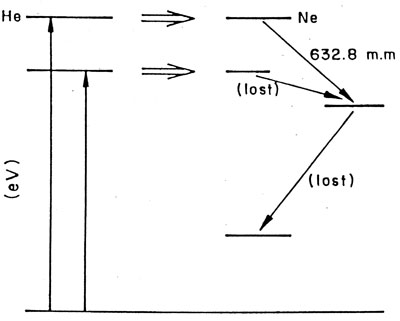d. Population Inversion: When the number of electrons in the metastable state exceeds that in the ground state it is called as population inversion.
e. Resonance: In the absence of collisions the electrons undergoing transition from the metastable state will emit radiation at the frequency that is equal to the absorption frequency. This is called as resonance.
f. Stimulated Emission: A photon released during emission from an electron in the metastable state can stimulate another high energy electron to release a photon of identical frequency, direction, polarization, phase and speed. The two photons are now completely identical and radiation is both temporally and spatially coherent. Stimulated emission and stimulated absorption in the ground state are equally probable. For a net emission, i.e., to construct a light source it is important to have a population inversion.
g. Cavity Oscillation: Starting with a gas with metastable states and population inversion, a light source can be constructed. However, the effectiveness of stimulation is increased by confining the gas between parallel mirrors. Here, reflections lead to increased stimulation and a large number of photons will surge back and forth in the cavity formed by the mirrors. Further the wavelength  for which the cavity length for which the cavity length  with with  being an integer will produce a standing wave pattern whose wavelength is being an integer will produce a standing wave pattern whose wavelength is  . Others wavelengths will be dissipated as thermal energy. A small opening in one of the mirrors will then generate a net monochromatic radiation of wavelength . Others wavelengths will be dissipated as thermal energy. A small opening in one of the mirrors will then generate a net monochromatic radiation of wavelength  that can be used in measurements. that can be used in measurements.
h. Helium-Neon Laser: A He  laser is a popular light source in optical instrumentation. It has a continuous wave output typically in the range of 0.5 to laser is a popular light source in optical instrumentation. It has a continuous wave output typically in the range of 0.5 to  and a wavelength of 632.8 nm. It is sturdy in construction, economical and stable in operation. A sketch of this laser is given in Figure 3.2. and a wavelength of 632.8 nm. It is sturdy in construction, economical and stable in operation. A sketch of this laser is given in Figure 3.2.

Figure 3.1: Atomic Transitions in a He-Ne Laser.
|